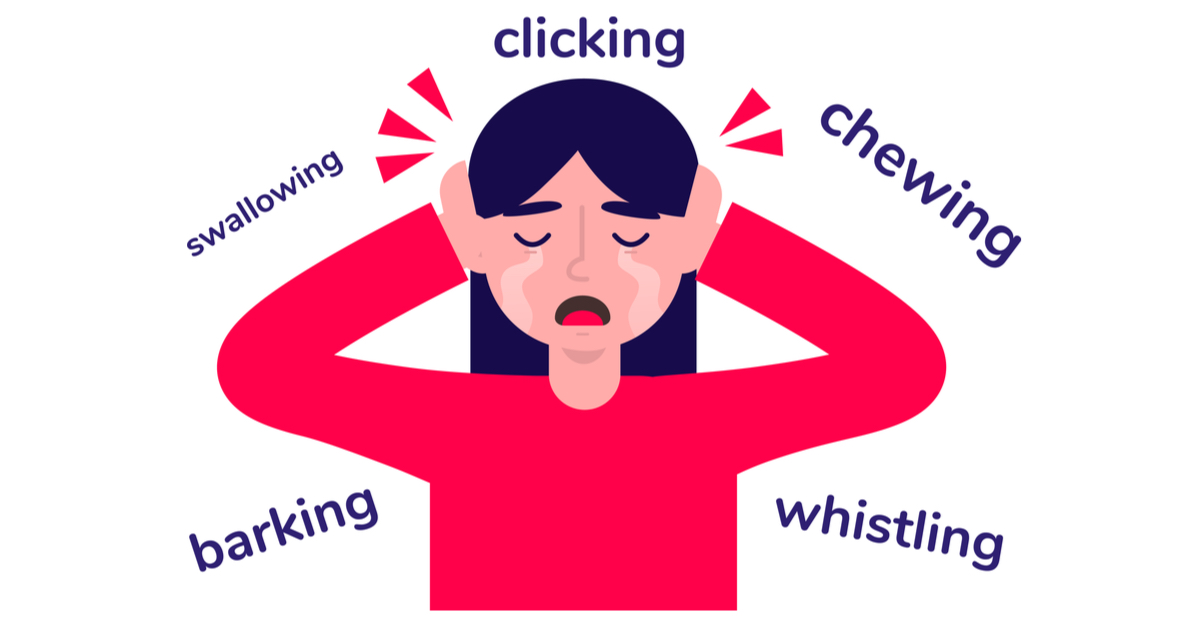
“Does it sound like someone is screaming in your ear?”
“No, it sounds like someone is screaming inside my brain.”
This is how a teenage patient of mine describes her experience of misophonia.
Misophonia is a psychological phenomena wherein a person is extremely sensitive to specific noises. Often a person with misophonia feels sudden rage or anxiety in response to their hated noises, followed by an urge to leave the situation immediately. Anything to make the disturbance stop.
Misophonia is not just a dislike of certain sounds, it is more than that. Often it is highly specific. For instance, a person might be disturbed by the sound of family members chewing or talking, but are able to tolerate these same noises from friends. Sometimes there are particular qualities, rather than particular people, that are disturbing. For example, wet, smacking sounds when a person is speaking, or the sound of a person clicking their pen, regardless of who is making the noise. This nuanced sound disturbance is a defining feature of misophonia, and helps assess whether a person’s sensitivity to noise is psychological in nature, or due to something else more physiological in origin.
Getting The Right Diagnosis: Who To Meet With, What To Look For
How do you know if you or a loved one is struggling with misophonia? This is a very important question, and one that is actively being investigated by researchers, as misophonia is just beginning to be recognized as a psychological condition. Reasons for noise sensitivity are being explored in a variety of different fields beyond psychology, including neuroscience, audiology, and otolaryngology (Brout et al., 2018).
Very often, misophonia is a diagnosis of exclusion. This means it is important to rule out other possible physical, sensory, neurological, and other psychological conditions, before arriving at a diagnosis of misophonia, which is currently considered an anxiety or obsessive-compulsive disorder. Comprehensive evaluation from a variety of professionals ensures that you are receiving the right treatment, and are not treating a medical concern with a psychological intervention.
The first stop on your rule-out list should be a meeting with an audiologist. An audiology assessment can help rule out a hearing concern, specifically tinnitus, or hyperacusis, which can have similar symptoms to misophonia. One of the defining differences between hyperacusis and misophonia, is that hyperacusis is a sensitivity to all noises based on intensity of the noise (i.e. volume), whereas misophonia is often a selective disturbance to noises based on situational factors (i.e. specific to only certain people who are making the identified noise, rather than a sensitivity to all noises of a certain intensity level).
You may also want to meet with an occupational therapist to rule out sensory processing disorder. This is another diagnosis that includes sensitivity to sensory information (i.e. textures, visual stimuli, as well as noises), however this is not currently a mental health diagnosis. Other evaluations to consider are meeting with a neurologist, or an Ear, Nose, and Throat doctor to rule out anything structural or physiological that could be causing the sensitivities. Finally, when you meet with a mental health professional, it is important to make sure they are evaluating for other diagnoses that can lead to sensitivity to sounds and sensory information, such as Autism Spectrum Disorder and Post Traumatic Stress Disorder (Brout et al., 2018; Jastreboff & Jastreboff, 2014; McKay et al., 2018).
You’ve Got Misophonia, Now How Do You Treat It?
Treatment of misophonia is a new and emerging field that is actively being explored by some of the brightest minds in psychology. Research with misophonia and related anxiety and obsessive-compulsive disorders suggests that a mixture of Cognitive Behavioral Therapy, Exposure and Response Prevention, and Acceptance and Commitment Therapy tools can be useful for building tolerance to noises, as well as managing distress related to noises (Frank & McKay, 2019; Schröder et al., 2017).
Research indicates that for many with misophonia, it may not be possible to “get rid” of the noise sensitivity. Therefore, it may be most helpful to focus on building tolerance to noises through repeated exposure to them under a variety of circumstances, while also learning to manage emotional reactions to the noises.
Preliminary evidence shows that this intentional practice of engaging with avoided noises can have a “downstream” effect on reducing the intensity of symptoms, and can provide generalized learning to other misophonic situations (Frank & McKay, 2019). This allows the person with misophonia to learn how to keep living their lives while they are disturbed, rather than accommodating their disturbance by leaving situations, wearing headphones, or avoiding triggers. In fact, accommodations (such as earplugs) may actually increase emotional sensitivity to noises (Jastreboff & Jastreboff, 2014).
Tools For Managing Misophonia: Practice, Practice, Practice!
How exactly can you practice building these skills? The following is a small selection of interventions based on currently available research with misophonia, combined with best practice using evidence-based treatments for related anxiety and obsessive-compulsive disorders. These tools are intended to help you get started on treating your misophonia.
Exposure – Intentional exposure to triggering noises can help you learn to engage with these noises on your own terms. This builds self-empowerment and increased tolerance of avoided experiences.
- Example: Take a triggering video, such as a video of family members eating, and replace the video soundtrack with something amusing or less aversive, such as a cartoon you enjoy, or a recording of your own noises. While playing both recordings simultaneously, gradually increase the sound of the family members, and decrease the sound of the alternative soundtrack.
Pairing – Pairing aversive noises with an enjoyable activities can allow for something called “counterconditioning”. Many triggering spaces and situations are avoided because of negative associations. By pairing these experiences with something positive, you have the potential to change these associations.
- Example: If you avoid eating sounds, pair a fun movie with a triggering person, while you both eat a delicious snack. If certain eating spaces such as the dinner table are avoided because they are associated with negative sounds, use the table for a fun activity like a boardgame.
Joining – Many people with misophonia describe feeling like they do not have power or control during triggering situations. One way to take the power back is to practice joining the noise, rather than leaving this situation.
- Example: Try to chew louder than the person you’re eating with, jiggle your own leg in tandem with the person who won’t stop tapping their foot, or click your pen with the classmate who never stops clicking that pen.
Redirection of Attention – Triggering noises often pull one’s full attention, which can further intensify feelings of distress, because the noise is all that is being noticed. Redirecting attention to other things going on around you can help reduce this distress.
- Example: One quick trick is to engage the five senses: what else can you see, hear, taste, smell, and touch? Dig deeper another layer. Can you hear beyond the house, or down the street? If you’re eating, really try to taste the food and experience the sensations of the food going down your throat and into your belly.
Distress Tolerance – Triggering noises often lead to strong emotional reactions. Learning to manage these reactions is important. This includes communication of distress: everyone is entitled to their emotions, but we are all still responsible for how we express them (I’m looking at you, teens).
- Example: Coping skills for regulating and soothing anger, distress, and anxiety in the moment can include Progressive Muscle Relaxation, breathing tools, or small experiences of enjoyment such as coloring or doodling. It is important that these tools are used to manage distress just enough to stay in the situation, and are not used to completely distract or avoid the noises, as this robs you of building skills for tolerating the noises.
Moving Forward
The treatment for misophonia is evolving every day. This article hopes to provide a baseline for starting your own treatment. After receiving appropriate comprehensive assessment, the best next step might be to pursue therapy with an anxiety therapist trained in evidence-based treatments, particularly exposure interventions. These specialists can help you apply the tools above, so that you can learn to manage your experience of misophonia, and live the full life you’re looking for.
References
Brout, J. J., Edelstein, M., Erfanian, M., Mannino, M., Miller, L. J., Rouw, R., … & Rosenthal, Z. (2018). Investigating misophonia: A review of the empirical literature, clinical implications, and a research agenda. Frontiers in Neuroscience, 12, 36.
Frank, B., & McKay, D. (2019). The suitability of an inhibitory learning approach in exposure when habituation fails: A clinical application to misophonia. Cognitive and Behavioral Practice, 26(1), 130-142.
Jastreboff, P. J., & Jastreboff, M. M. (2014, May). Treatments for decreased sound tolerance (hyperacusis and misophonia). In Seminars in Hearing (Vol. 35, No. 02, pp. 105-120). Thieme Medical Publishers.
McKay, D., Kim, S. K., Mancusi, L., Storch, E. A., & Spankovich, C. (2018). Profile analysis of psychological symptoms associated with misophonia: a community sample. Behavior therapy, 49(2), 286-294.
Schröder, A. E., Vulink, N. C., van Loon, A. J., & Denys, D. A. (2017). Cognitive behavioral therapy is effective in misophonia: An open trial. Journal of Affective Disorders, 217, 289-294.
Face your fears. Live with uncertainty. Take control of your life.
Dr. Megan Faye, is a Licensed Psychologist specializing in the assessment and treatment of anxiety disorders, OCD, and eating/feeding disorders, and misophonia.

